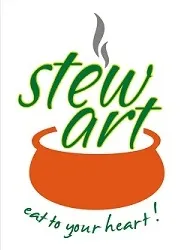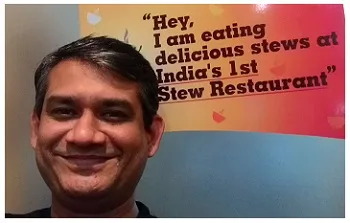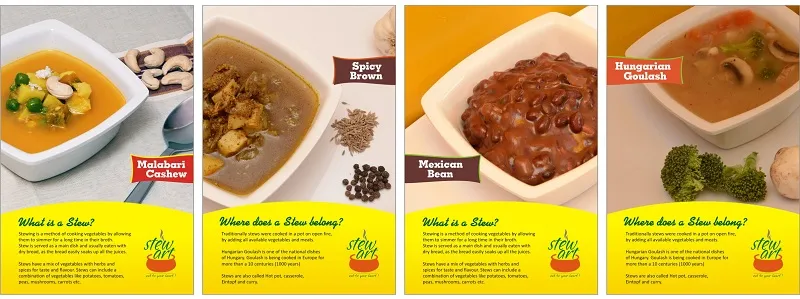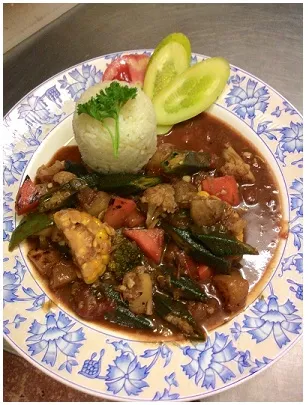May the stew be with you! Pune-based Stew Art experiments with a different kind of food

What’s in a stew? Vegetables and/or meat cooked over a low flame, simmered for a long time with herbs and spices and served with bread, ‘appams’ or rice depending on where the stew originated from.
Stews have been around for more than 8,000 years when tribes from the Amazon rain-forest to Europe and Central Asia would use the shells of turtles or large mollusks as vessels to boil food in. As Indians, we’ve all had our fair share of stew in the staple daal and sambar (yeah, I didn’t know they classified as stew either!). “Stews fall somewhere between a soup and a curry; not as bland and simple as a soup, and not oily and spicy like a curry,” says Hemant Thite, Founder of Pune-based Stew Art, a stew-only joint, where people can explore the rich diversity of tastes that stews have to offer.
Who?
As a father of two, Hemant’s prime concern with feeding his kids was to make sure they were eating healthy. His first venture was a franchise outlet of a popular ice-cream and milkshake brand that he ran for three years before deciding he wanted to start something of his own. He had an option to start a pizza outlet post the ice-cream and milkshake shop, but turned it down to opt for an “amazing, fulfilling, guilt-free, and healthy dining experience.”

What?
Soon enough Stew Art started operations on Valentine’s Day this year with the tagline ‘taste falls in love with health’. “The food was inspired by cultures in Central America, Italy, Singapore, Malaysia and India. While researching for recipes, I found that stews are globally popular and can be made as healthy as you want,” explains Hemant. Along with managing operations at his restaurant, Hemant is a visiting professor of Creativity and Innovation at a prestigious college in Pune.
Branding
Given how most of us don’t go around calling our daal or sambar a stew, Hemant realized that stew, as a concept, was new to India. “Stew Art is India’s first stew restaurant. We didn’t have any benchmarks or any role models to follow. During the initial days, we would have one of our staff stationed outside the restaurant distributing leaflets to anyone who looked at the restaurant. It makes me laugh now, but it actually worked. Our initial promotional activities were guided by the need to educate people about stews and to present stews as an exciting ‘must try once’ experience,” reveals Hemant.
What’s on the menu?
The restaurant currently has nine stews on the menu: four Indian stews (Malabari Cashew Stew, Ghughni, Spicy Brown Stew and Mangalorean Coconut Stew) and five International stews (Hungarian Goulash, Moroccan Stew, Mexican Bean Stew, American Gumbo and Corn Chowder). “Each serving uses less than 4ml of oil or butter for cooking,” beams Hemant.

A lot Stew Art’s branding revolves around educating the customer. Posters and art on the walls of the restaurant talk about the history of stews, methods of cooking, serving and eating the stew, etc. The staff has been specifically trained to engage the customers in conversation about the stew that they are eating. “We don’t have a specific customer base. Our customers include college kids, families, children and senior citizens. Our stews are not only light on health but they’re light on the pocket too!” states Hemant. The restaurant has used print (leaflests, print ads, etc.) and social media (Facebook presence, food/deal websites, etc.) to spread awareness. They’ve also conducted a few sessions called ‘Stew Art Story’ at a couple of colleges in Pune.

Traction
“We serve anywhere between 60-100 meals a day. It’s slightly less than we expected, but the growth is pretty good. I think we can attribute the low numbers to a not-aggressive enough marketing strategy and the general lack of knowledge among the customers with regard to what to expect from a stew,” reveals Hemant.
The meat and vegetables for the stews are picked up directly from the main city market to ensure freshness, quality and value for money. The spices are procured whole from the source and are ground at the restaurant, while the whole-wheat bread is custom made. “To deal with the volatility in prices, we source fresh from the source, where it is the cheapest, and we keep a steady stockpile of some of the raw produce,” reveals Hemant. “Inventory management is crucial to reduce wastage and to keep our cost of production in a specific range,” he adds.
Future
Stew Art currently has eight new exciting stews in the pipeline which will be launched within the next three months. The stews go through multiple levels of taste testing before they are approved for launch. Hemant has enlisted the help of the members of the Pune foodies group, food bloggers, friends, family and regular customers. “The customer is king at the end of the day. We need to get their approval before we launch a new stew,” states Hemant. In the future, he plans to get a few celebrity chefs on board for product development and marketing.
“We have a lot of space in our current outlet which we plan to use as a central kitchen when we plan to start giving our brand out for franchising in Pune. That’s how we plan to maintain the quality of the product,” signs off Hemant.
Check out their Facebook Page.
This story is a part of the ‘F&B Entrepreneurs’ series presented in association with ‘Chilli Paneer – A DBS Production'.







